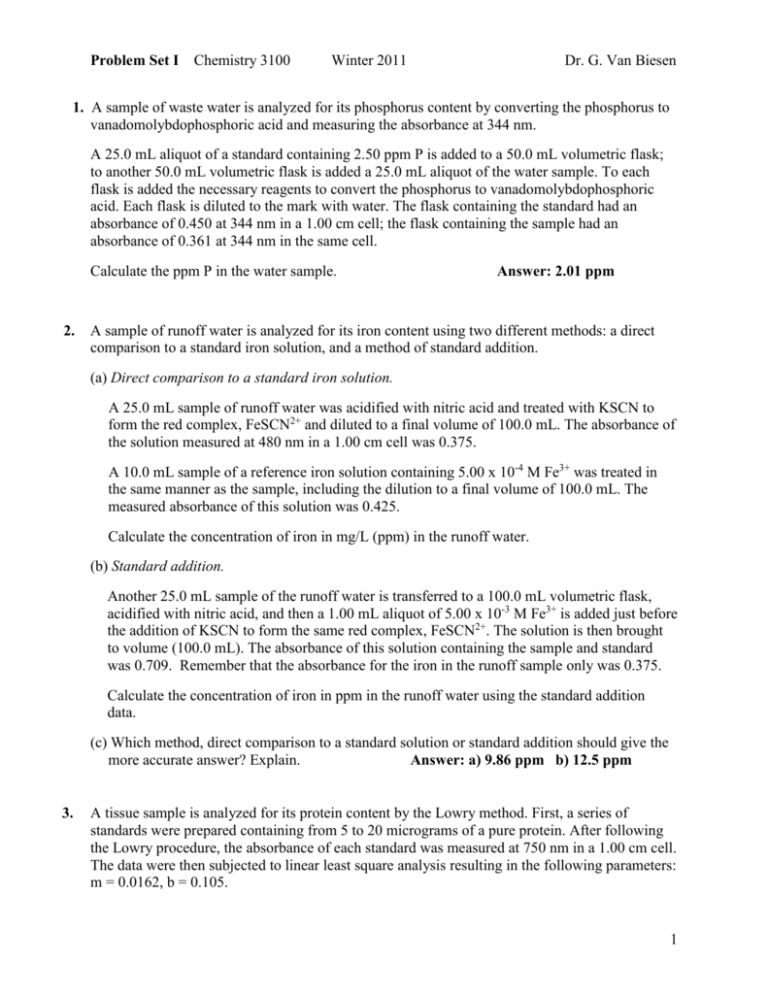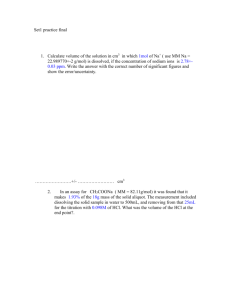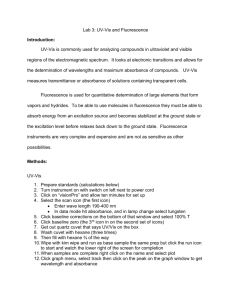Chemistry Problem Set: Spectrophotometry & Titrations
advertisement

Problem Set I Chemistry 3100 Winter 2011 Dr. G. Van Biesen 1. A sample of waste water is analyzed for its phosphorus content by converting the phosphorus to vanadomolybdophosphoric acid and measuring the absorbance at 344 nm. A 25.0 mL aliquot of a standard containing 2.50 ppm P is added to a 50.0 mL volumetric flask; to another 50.0 mL volumetric flask is added a 25.0 mL aliquot of the water sample. To each flask is added the necessary reagents to convert the phosphorus to vanadomolybdophosphoric acid. Each flask is diluted to the mark with water. The flask containing the standard had an absorbance of 0.450 at 344 nm in a 1.00 cm cell; the flask containing the sample had an absorbance of 0.361 at 344 nm in the same cell. Calculate the ppm P in the water sample. 2. Answer: 2.01 ppm A sample of runoff water is analyzed for its iron content using two different methods: a direct comparison to a standard iron solution, and a method of standard addition. (a) Direct comparison to a standard iron solution. A 25.0 mL sample of runoff water was acidified with nitric acid and treated with KSCN to form the red complex, FeSCN2+ and diluted to a final volume of 100.0 mL. The absorbance of the solution measured at 480 nm in a 1.00 cm cell was 0.375. A 10.0 mL sample of a reference iron solution containing 5.00 x 10-4 M Fe3+ was treated in the same manner as the sample, including the dilution to a final volume of 100.0 mL. The measured absorbance of this solution was 0.425. Calculate the concentration of iron in mg/L (ppm) in the runoff water. (b) Standard addition. Another 25.0 mL sample of the runoff water is transferred to a 100.0 mL volumetric flask, acidified with nitric acid, and then a 1.00 mL aliquot of 5.00 x 10-3 M Fe3+ is added just before the addition of KSCN to form the same red complex, FeSCN2+. The solution is then brought to volume (100.0 mL). The absorbance of this solution containing the sample and standard was 0.709. Remember that the absorbance for the iron in the runoff sample only was 0.375. Calculate the concentration of iron in ppm in the runoff water using the standard addition data. (c) Which method, direct comparison to a standard solution or standard addition should give the more accurate answer? Explain. Answer: a) 9.86 ppm b) 12.5 ppm 3. A tissue sample is analyzed for its protein content by the Lowry method. First, a series of standards were prepared containing from 5 to 20 micrograms of a pure protein. After following the Lowry procedure, the absorbance of each standard was measured at 750 nm in a 1.00 cm cell. The data were then subjected to linear least square analysis resulting in the following parameters: m = 0.0162, b = 0.105. 1 Problem Set I Chemistry 3100 Winter 2011 Dr. G. Van Biesen Next, the tissue sample weighing 2.10 mg was digested to release the protein then diluted to 100.0 mL. A 2.00 mL aliquot of this solution was analyzed by the Lowry procedure in the same manner as the standards resulting in an absorbance of 0.230 in a 1.00 cm cell. Calculate the % protein in the sample. Answer: 18.4 % 4. The molar absorptivity of an aqueous solution of the amino acid tryptophan (204 g/mol) is 5495 at 278 nm. (a) Calculate the expected absorbance at 278 nm of a 4.3 x 10-5M solution of tryptophan if a 1.50 cm cell was employed. (b) What is the molar concentration of a tryptophan solution having an absorbance of 1.16 in a 0.96-cm cell? Answers: a) 0.35 AU b) 2.2 x 10-4 M 5. The concentration of barbital (a barbiturate) in a blood sample was determined by extraction from 3.00 mL of blood into 15.0 mL of CHCl3 (chloroform). The barbital was then extracted from chloroform with 10.0 mL of 0.045 M NaOH(aq) (pH = 13.00). The absorbance of the solution at 260 nm was measured and found to be 0.115. The pH of a 3.00 mL aliquot of the aqueous solution is then is then adjusted to pH 10* by adding 0.50 mL of 16% of ammonium chloride (NH4Cl). The absorbance of this solution was 0.023. A 30.0 ppm standard barbital solution handled in the same way gave the following results: at pH 13: A = 0.295; at pH = 10, A = 0.002. Calculate the concentration of the barbital in the blood sample in ppm. *At pH =10, barbital does not absorb at 260 nm, any absorption at this pH is due to matrix components. Assume the magnitude of absorbance by the matrix components to be the same at both pH values. Hint : don't forget about dilution for the blank. Answer: 9.0 ppm 6. A 3.1250 g sample of hair from a person with suspected lead poisoning was analyzed by atomic absorption spectrometry (AAS). The sample was digested to destroy the organic matrix and the resulting solution diluted to 100.0 mL. The absorbance of this solution was 0.250. Next, 0.200 mL of a standard solution containing lead at a concentration of 1.33 x 10-4 mol L-1 is added to 50.0 mL of the sample solution and the absorbance measured giving a value of 0.360. Calculate the lead content of the hair in μg Pb per gram (parts-per-million dry weight). Answer: 7.91 ppm 7. A certain analytical methods is known to give a relative standard deviation of 5 ppt (parts per thousand) or better. A sample is first analyzed three times using this method with the following results: 43.22%, 43.25%, 43.65%. Because the 43.65% result seemed questionable two additional results were obtained as follows: 43.30% and 43.49%. 2 Problem Set I Chemistry 3100 Winter 2011 Dr. G. Van Biesen a) What is the relative standard deviation of the first set (n=3) and of the complete set (n=5). b) Evaluate the precision of each of the two sets of results. I.e. which data set is acceptable? Answer: for n =3, 6 ppt and n=5, 4 ppt 8. A sample of contaminated soil was dried in an oven at 120 oC and a 1.20-g sample selected for analysis for its level of cadmium by atomic absorption spectroscopy (AAS). The sample was first dissolved in acid and then transferred to a 250 mL volumetric flask and diluted to the mark. Then two 25.00 mL aliquots were added to separate 250 mL volumetric flasks. To one of the 250 mL volumetric flasks, a 5.00 mL spike of 1.00 ppm standard cadmium solution is added and then both flasks diluted to the mark. The absorbance of the solution at 228 nm without added standard was 0.288; with added standard it was 0.664. Determine the level of cadmium in the soil in g Cd/g of soil. Answer: 31.9 g/g 9. Calcium in a sample solution is determined by atomic absorption spectrophotometry. A stock solution of calcium is prepared by dissolving 1.834 g of CaCl2 · 2 H2O in water and diluting to 1.00 L. This is diluted 1:10. Working standards are prepared by diluting the second solution, respectively, 1:20, 1:10, 1:5. The sample is diluted 1:25. Strontium chloride is added to all solutions before dilution, sufficient to give 1% (wt/vol) to avoid phosphate interference. A blank is prepared to give 1% SrCl2. Absorbance signals recorded when the solutions are aspirated into an air-acetylene flame are as follows: blank A= 0.015; standards, 0.105, 0.201, 0.385; sample 0.296. What is the concentration of calcium in the sample in parts per million? Answer: 190 ppm 10. Ksp for AgBr is 4.0 x 10-13. Calculate the following for a titration of 0.01 M Br with 0.01 M silver (I). a) pAg when 99% of the bromide has been titrated. Ans: 8.1 b) pAg at the equivalence point. Ans 6.20 11. A 25.0 mL solution containing 0.0500 M Cd2+(aq) and 0.100 M Ag+(aq) is titrated with 0.050 M CO32- (aq). Ksp CdCO3 = 1.8 x 10-14; Ksp Ag2CO3 = 8.1 x 10-12 (a) Show that CdCO3 precipitates first. (b) Show whether or not Ag2CO3 has started to precipitate at the first equivalence point. (c) Calculate pCO32- after the additions of 10.0 mL, 20.0 mL, 25.0 mL, 30.0 mL, 40.0 mL, 50.0 mL, and 65.0 mL of the titrant. Answer: a) calculate minimum concentrations of carbonate to precipitate each b) Qsp>Ksp precipitation occurs c) 12.08, 11.49, 8.49, 8.21, 7.47, 3.89, 1.94 3








